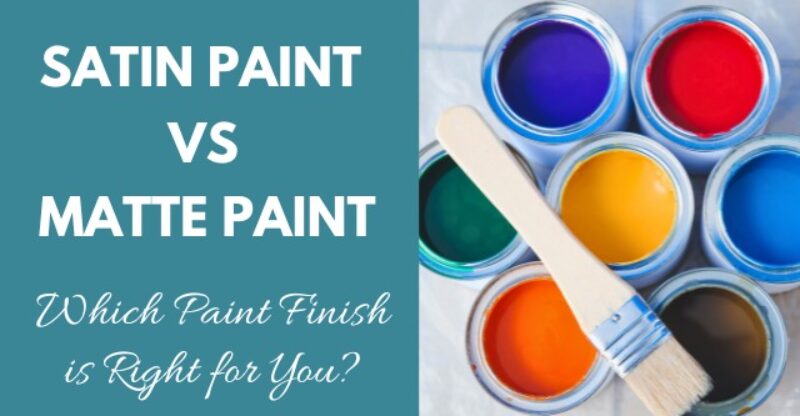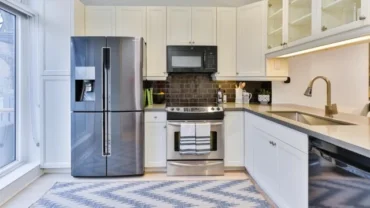Satin Paint vs Matte Paint: Which Paint Finish is Right for You?
Stuck on which paint finish to choose. Matte vs. satin paint? These are the two most popular among interior designers and homeowners.
But how can you differentiate between these two paint finishes? The main difference between satin and matte paint is that satin is shinier.
The reason is that satin paint has a higher gloss of up to 27% to 45%, and matte finish has a gloss percentage of less than 10%. That means that satin paint will reflect 26% – 40% more lights compared to matte, where the percentage is 5% -10%.
So the debate ends here that satin is more gloss finish than matte.
On the other hand, satin paint is more durable and easy to clean than matte finish. But matte paint hides imperfections and is easier to apply at a cheaper price compared to satin paint.
In this blog, we will show you the key differences in both finishes and guide you to choose the right finish.
Paint Sheen Difference in Simple Graph
Before we dive into the graph, it’s important to note that the terms ‘sheen’ and ‘finish’ are often used interchangeably in the world of paint to describe the level of shine a particular paint has.
Taking a look at the graph, we are introduced to a spectrum of finishes: flat, matte, eggshell, satin, semi-gloss, and gloss. These are common terms you’ll encounter across major paint brands like Benjamin Moore, Sherwin Williams, and even at your local Home Depot.
The graph illustrates a clear trend: the shinier the paint, the more durable it is. So, at one end of the spectrum, we have gloss paint, which boasts a high sheen and is the most durable option available.
It’s the kind of paint you might choose for areas that need to withstand a lot of wear and tear. On the other end, flat paint offers less shine and, consequently, less durability.
However, it has a special superpower: it can hide imperfections with ease. That’s why it’s often the go-to choice for ceilings in bedrooms, bathrooms, and kitchens. Its ability to absorb light results in a soft finish that can make any room feel cozy and well-crafted.
Now, matte paint often gets mentioned in the same breath as flat paint, but it’s got a bit more of a sheen to it. It’s the finish you’d want when you’re looking to disguise those pesky overlapping brush marks, making it a favorite for interior walls.
As we move up the graph, we encounter satin paint, which has a higher shine than matte. It’s a bit trickier to apply, but its durability makes it perfect for high-traffic areas where you need a finish that can take a bit of a beating.
Satin vs. Matte: Key Differences
Both Satin and matte are very close on a sheen scale, but they have a huge difference in terms of durability, cost, texture, and sheen.
Satin Paint
Satin paint lies in the middle of the sheen scale and has a gloss level higher than matte but flatter than semi-gloss.
It gives high reflectivity with a durable sheen that has set a high standard for cabinetry, trim, and doors.
Satin generally works well in higher-traffic areas like kitchens, family rooms, and bedroom walls Because it is easier to clean and more resistant for a long time than matte.
Advantages/Pros of Satin Paint
- Provides a moderate shine that complements a wide range of paint hues
- Forms a resilient surface
- Can endure regular cleanings and scrubbing
- Suitable for application on both walls and decorative trim
- Simpler to maintain and more robust than matte or flat paint
- Offers better resistance to moisture compared to paints with less gloss
- Reflects a greater amount of light, helping to brighten and enlarge smaller, darker spaces
Disadvantages/Cons of Satin Paint
- More challenging to apply and correct without visible inconsistencies
- Pricier per gallon compared to flat or matte paints
- Fails to conceal wall irregularities and bumps effectively
- Highlights more flaws than smoother options like eggshell and matte
- Exposes more application errors, such as streaks, texture inconsistencies, and drips
- Costs more than matte paint
Matte Paint
Matte paint is the flattest on paint sheen because of its low gloss percentage, which means it will reflect less light than most paints.
It is recommended to use matte paints in ceilings, walls, or low-traffic areas that do not dirty often. It is a very cheap per-gallon application. The application process is easy, making it ideal for beginner DIY painters.
Due to its ability to absorb light, it is good to hide imperfections in walls that are older and need repair or renovation after a lot of time.
Advantages/Pros of Matte Paint
- Great at hiding wall blemishes
- Easy to put on with few noticeable errors
- Gives a smooth, velvet-like finish
- Cheaper than satin paint
- High-color content for excellent coverage
- Simple to apply and fix
- Costs less per gallon than satin or semi-gloss paints
- Shows fewer wall flaws and covers better
- Gives a rich, velvet-like finish, perfect for modern designs
Disadvantages/Cons of Matte Paint
- Doesn’t handle regular cleaning or scrubbing well
- Not a good fit for places like bathrooms and kitchens
- Not strong enough for trim and moldings
- Mainly used for walls and ceilings
- Hard to clean and not so good against scuffs
- Not very good at resisting moisture, so not great for the kitchen or bathroom
- Absorbs light, which can make small rooms look even smaller
| Paint Type | Reflectivity | Durability | Best Used In |
| Satin Paint | High | High | Kitchens, Bathrooms, High Traffic Areas |
| Matte Paint | Low | Medium | Bedrooms, Ceilings, Living room, Low Traffic Area |
Conclusion
It’s time to turn a dream into reality with all this information about which paint finish to choose between satin paint vs matte paint.
Both paint finishes have different functionality according to space utilization. One of the benefits of choosing the right finish is to increase your home value.
According to Zillow’s research, 40% of home resellers do a new paint finish before selling their home, and almost 30% have agreed that this helps their home sell at a bitter price.
I hope we have answered all your questions about which paint finish to use. One pro tip is no matter which finish to use, do a quality paint so that it lasts longer.
FAQs
Matte paint provides better coverage and is more cost-effective than satin paint. Both have different applications matte can be used in low-traffic areas while satin can be used in high-traffic areas.
Due to its easy-to-clean nature and durability, it is a popular choice for interior walls in the family room, kitchens, and kids room.
Both paint finishes are easily available at home improvement stores like online platforms Amazon, Home Depot, and Walmart.
Satin paint is 20 – 25% more expensive than matte per gallon. The average satin paint costs $64 – $70 versus $45 – $50 per gallon of matte paint. This is because gloss is more expensive than pigments. Satin paint has a higher gloss ratio and fewer pigments.



